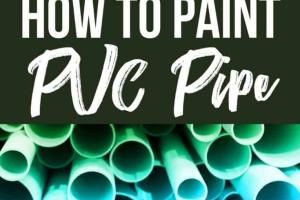Ultimate Guide: How to Paint PVC for Long-lasting Results

-
Quick Links:
- Introduction
- Understanding PVC
- Why Paint PVC?
- Essential Tools and Materials
- Surface Preparation
- Painting Techniques
- Finishing Touches
- Case Studies
- Expert Insights
- FAQs
Introduction
Painting PVC (polyvinyl chloride) can seem daunting at first, but with the right techniques and tools, you can achieve stunning results. This guide will walk you through everything you need to know about painting PVC, from understanding the material to selecting the right paint. Whether you’re sprucing up your home, creating outdoor décor, or working on a DIY project, this comprehensive guide will equip you with the knowledge to successfully paint PVC.
Understanding PVC
PVC is a versatile plastic used in a variety of applications, from plumbing pipes to outdoor furniture. Its durability and resistance to moisture make it a popular choice for both indoor and outdoor projects. However, PVC can be tricky to paint due to its smooth surface and non-porous nature. Understanding the characteristics of PVC is crucial for achieving the best results when painting.
Why Paint PVC?
There are several reasons to paint PVC:
- Aesthetic Appeal: Adding color can enhance the visual appeal of PVC items.
- Protection: Paint can provide an extra layer of protection against UV rays, moisture, and wear.
- Customization: Painting allows for personalization, making your projects unique.
- Durability: Quality paint can increase the longevity of PVC items.
Essential Tools and Materials
Before you start painting, gather the following tools and materials:
- Fine grit sandpaper
- Cleaning solution (soap and water or a PVC cleaner)
- Primer (specifically for plastic)
- Paint (acrylic, spray paint, or specialized plastic paint)
- Paintbrush or spray gun
- Drop cloths or newspapers
- Masking tape
- Protective gear (gloves, mask, goggles)
Surface Preparation
Proper surface preparation is vital for a successful paint job on PVC. Follow these steps:
- Clean the Surface: Remove dirt and grime using a cleaning solution.
- Sand the Surface: Lightly sand the PVC with fine grit sandpaper to create a rough texture for better paint adhesion.
- Wash Again: Rinse off any sanding dust and let the surface dry completely.
- Apply Primer: Use a plastic primer to ensure better paint adhesion. Allow it to dry as per the manufacturer's instructions.
Painting Techniques
Once the surface is prepared, it’s time to paint. Here are some effective techniques:
Brush Painting
Using a brush allows for greater control and precision.
- Dip the brush into the paint and remove excess paint.
- Use long, even strokes to apply the paint, ensuring full coverage.
- Allow the first coat to dry completely before applying a second coat.
Spray Painting
Spray painting can provide a smooth and even finish.
- Shake the spray can or spray gun to mix the paint thoroughly.
- Hold the spray can or gun about 6 to 12 inches away from the surface.
- Apply thin, even coats, moving the spray can or gun in a continuous motion.
Finishing Touches
After applying the paint, here’s how to finish up:
- Inspect the painted surface for any missed spots or uneven areas.
- Touch up any areas as needed.
- Allow the paint to cure fully before using or handling the PVC item.
Case Studies
To illustrate the effectiveness of proper PVC painting techniques, let’s explore a few case studies:
Case Study 1: Outdoor Furniture
A homeowner painted PVC outdoor furniture to match their backyard decor. By following the surface preparation steps and using a UV-resistant paint, the furniture remained vibrant and protected for over three years.
Case Study 2: Garden Planters
A DIY enthusiast painted PVC planters for their vegetable garden. After priming and using high-quality acrylic paint, the planters not only looked beautiful but also resisted fading and cracking, allowing for successful gardening seasons.
Expert Insights
We consulted with home improvement experts and professional painters to gather valuable insights:
"Preparation is key when painting PVC. Skipping the sanding step can lead to peeling and chipping paint." - John Doe, Professional Painter
"Always choose high-quality paint designed for plastics. It makes a significant difference in durability." - Jane Smith, Home Improvement Specialist
FAQs
1. Can you paint PVC without primer?
While it is possible, using primer increases paint adhesion and durability.
2. What type of paint is best for PVC?
Acrylic paint or specialized plastic paint is recommended for best results.
3. How long does painted PVC last?
With proper preparation and quality materials, painted PVC can last several years.
4. Do I need to sand PVC before painting?
Yes, sanding helps with paint adhesion and creates a better surface for the paint to grip.
5. Can I use spray paint on PVC?
Yes, spray paint can provide a smooth finish, but ensure it is suitable for plastic.
6. How do I clean painted PVC?
Use mild soap and water; avoid abrasive cleaners that can damage the paint.
7. How can I prevent peeling paint on PVC?
Proper surface preparation and using quality paint are crucial to avoid peeling.
8. Can I paint PVC pipes?
Yes, you can paint PVC pipes using the same techniques, but ensure the paint is suitable for plumbing applications.
9. Is it safe to paint PVC for indoor use?
Yes, as long as you use non-toxic paint suitable for indoor use.
10. How do I know if the paint has cured completely?
Check the manufacturer’s drying and curing times; typically, it takes several days to cure fully.
Conclusion
Painting PVC can transform your projects and enhance their longevity. By following the steps outlined in this guide, you can achieve professional-looking results. Remember to invest time in preparation and select the right materials for the best outcome. Happy painting!